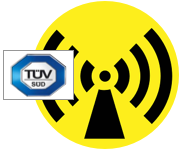Safety Training
Aims:
Electromagnetic field (EMF) safety of workplaces and products are two safety responsibilities applying to a wide range of employers and manufacturers for protection of the health of employees and the general public. Workplaces are subject to health and safety regulation such as the introduction of the EU Physical Agents Directive for EMF, 2013/35/EU. Electrical products must comply with essential health and safety requirements before placing them on the market and are regulated in the EU under CE marking Directives with specific standards for EMF safety.
The topic of EMF safety is explained on this course together with its regulation, management and assessment with practical measurement examples. It applies to industries including communications, radar, industrial processing, medicine and other fields.
Who should attend
Those involved in the design, installation, operation and maintenance of electrical products and installations producing electromagnetic fields. Safety practitioners from all disciplines; supervisors and managers of people working with EMF; people from other disciplines who use EMF in research, medical work and other industries.
Benefits of Attending
Protect employees and the general public from EMF health hazards.
Enable compliance with Health and Safety regulation and guidance.
Hands on use of measurement instrumentation.
Course Content:
Course Objectives
*Understand the nature and properties of electromagnetic fields (EMF) and the difference between ionising and non-ionising radiation.
*Understand the health effects of EMF on the human body including shocks and burns and indirect hazards to, flammable atmospheres, Electro Explosive Devices (EEDs) and medical implants.
*To be able to identify and comply with the current and future EU regulation including the EU Physical Agents (EMF) Directive and create a workplace EMF safety policy.
*To be able to identify and comply with current product EU Directives, EMF standards and their assessment methods.
*Understand the need for basic exposure limit value restrictions and the permitted electric, magnetic and power density exposure action levels.
*To be able to select and operate suitable EMF monitoring equipment and perform risk assessment surveys to address both thermal and non-thermal effects of exposure due to intentional transmissions and leakage.
*To perform simple predictions of EMF radiation from different types of antenna.
Course Content
*Electromagnetic Fields (EMF): The nature of electromagnetic fields, the electromagnetic spectrum and the distinction between ionizing and non-ionizing radiation. The units used in measuring field strength and power density. The effect of waveshape and modulation.
*EMF Effects on the Human Body: The thermal effects of EMF radiation on the human body and the coupling variation with frequency. The low frequency electrostimulation effects on the human body. The risk of electric shock and burns associated with contact currents. The indirect effects of EMF on medical devices, flammables and Electro Explosive Devices. Research into possible long term effects on people.
*EMF Regulation: EMF documents; Physical Agents Directive (EMF) 2013/35/EU, general public guidance for Europe 1999/519/EC, International ICNIRP, US IEEEC95.1. Basis of EMF exposure; exposure limit values/basic restrictions and the measurable action/reference levels. Workplace and product EMF standards. Status of regulation of long term effects.
*Workplace EMF Safety Management: Safety management & policy and the need for a competent person. Risk assessment from initial to detailed assessment. Resulting safety controls and zoning. Dealing with incidents and medical assistance. Other possible exposure hazards.
*Measurement of Thermal Effects: Handheld EMF meters and operation. The use of time averaging and spatial averaging. Dealing with moving beams and multiple Sources. Personal monitor PPE and area monitors. Current monitor for induced and contact currents. Equipment leakage measurement. Calibration and measurement uncertainty.
*Measurement of Non-Thermal Effects 0-10MHz: Magnetic field and electric field measurement instruments. Methods for AC
power system, railway, welding and induction heating measurement.
*Spectrum Analyser Measurement: Spectrum analysers and their use with measurement antennas. Consideration of IF bandwidth, mean & peak power, scanning/rotational averaging factor and field to power density conversion. Basestation method. Calculation of total exposure ratio.
*Product Directives, Standards and Methods: EU regulatory compliance, EU Directives and their harmonised standards.
Wireless product standards and methods for SAR measurement, EMF scanning and EMF calculation. Non-wireless product standards and methods for welding, household, lighting and machinery products.
*Calculation of EMF due to Antennas: Basic antenna theory and antenna gain. Wire and aperture antenna types. Near and far fields. Rayleigh distance and aperture antenna near field. HF, VHF and UHF antenna general case.
*Radar Calculation and Measurement: Calculation methods flow chart. Far field power density calculation to give compliance boundary. Shinn diagram method and use for survey planning. Measurement approach and consideration of meter response time and application of scanning factors. Leakage measurement.
*Large Transmitter Site Risk Assessment: Need for site risk assessment survey. Collection technical data. Planning exercise. Application of safety controls. Leakage checklist .
Course Duration
2 daysNumber of Delegates
Certification
Delegates will receive a Certificate from TUV SUD upon successful completion


